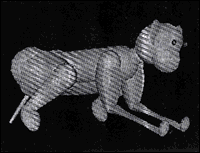
A Weizmann Institute-Brown University study has shown that object recognition by the human brain is far simpler than has been commonly thought, a finding that may facilitate the design of more effective vision-related systems, ranging from household robots to smart weapons.
Scientists have long been puzzled by the ability of the brain to reconstruct three-dimensional images from information conveyed by the two-dimensional retina. In a recently published study, Dr. Shimon Edelman of the Weizmann Institute's Department of Applied Mathematics and Computer Science and Prof. Heinrich Bulthoff of Brown University have determined that object recognition may be accomplished through a relatively simple process involving a comparison of two-dimensional views. Upon receiving input about an object, the brain compares its 2-D coordinates to a series of memorized "snapshots" of previously-seen objects. Recognition takes place when the brain, through interpolation, selects the "snapshots" that most closely approximate the new object.
In these studies, subjects were first shown computer images of a previously unseen 3-D object -- or "target" -- as viewed from various vantage points. The participants were then presented with single views of either the target or a "distractor" -- an object similar to but not identical to it. The researchers showed that the subjects could successfully identify the target only when its change in orientation was small enough for interpolation to take place, an indication that learned "snapshot" images and not mentally rotatable dimensional models underlie object recognition.
Funding for this research was provided by the U.S. Navy. Dr. Edelman holds the Elaine Blond Career Development Chair.
